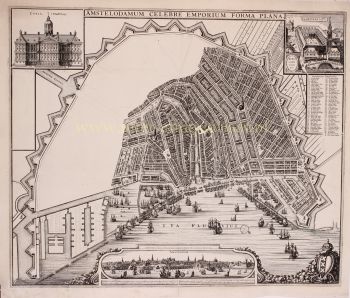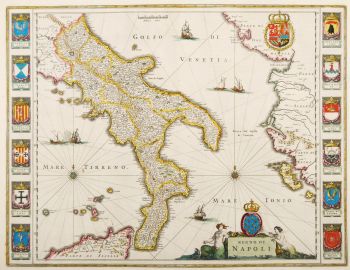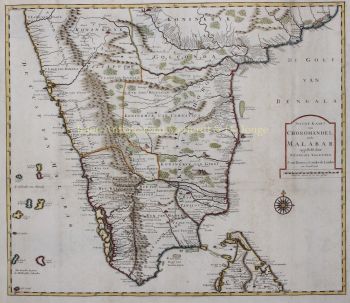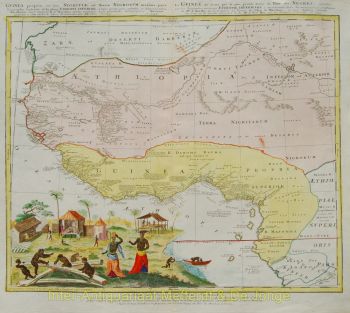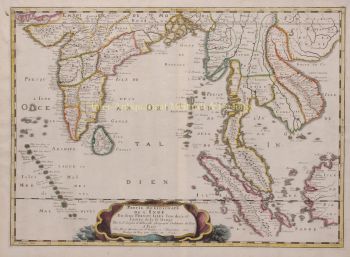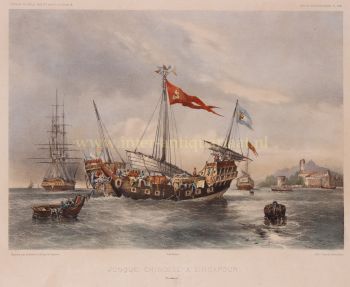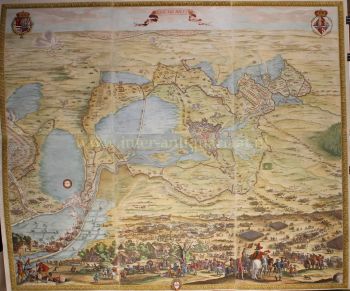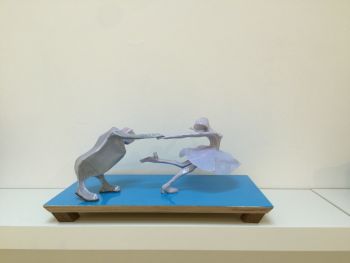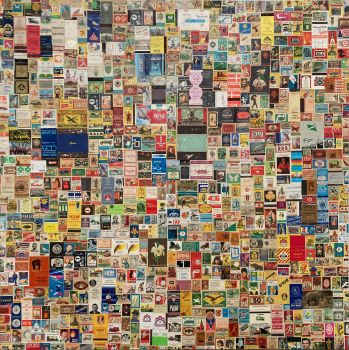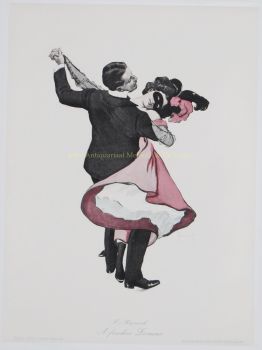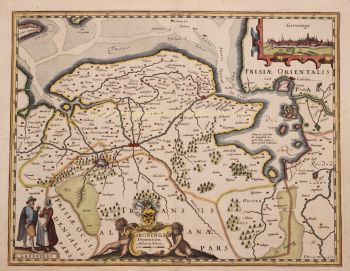The city of Delft in 1649 1649
Joan Blaeu
InktPapierAfdrukken
48 ⨯ 57 cm
€ 1.850
Inter-Antiquariaat Mefferdt & De Jonge
- Over kunstwerkTHE CITY OF DELFT "Delfi Batavorum vernacule Delft", copper engraving, published in Amsterdam by Joan Blaeu in 1649. Size (print) 37,7 x 48,5 cm. Coloured by a later hand. Verso: Latin description of Delft. Until the 17th century, Delft was one of the major cities of Holland. Already in 1400, the city had 6500 inhabitants and was the third largest in size, after Dordrecht (8000) and Haarlem (7000). In 1560 Amsterdam with 28,000 inhabitants had become the largest city, followed by Delft, Leiden and Haarlem, each of which had about 14,000 inhabitants. In the 17th century, Delft experienced a new heyday. A Chamber of the VOC was established in Delft. The city sent a fleet to Southeast Asia three times a year, importing spices, Chinese porcelain and other luxury goods. The tradition of Delftware originated from the import of Chinese porcelain, with an extensive pottery industry. During the Eighty Years' War, Delft became a center of resistance against the Spanish, after several cities and territories managed to evade Spanish authority in the 1570s. Prince William of Orange briefly resided in Delft, in the former Sint-Agatha monastery, which has since been called Prinsenhof. After William of Orange was declared an outlaw by King Philip II, he was also murdered there by Balthasar Gerards in 1584. William of Orange is buried in the Nieuwe Kerk, clearly visible on the map on the market square. After William of Orange, 45 members of the House of Orange and the House of Orange-Nassau were buried in the royal crypt. This map was published after the Peace of Münster (1648) as part of Joan Blaeu's town book of the Netherlands "Novum Ac Magnum Theatrum Urbium Belgicae Liberae Ac Foederatae". The Amsterdam cartographer and publisher Joan Blaeu set himself the task of simultaneously achieving the objectives of Abraham Ortelius (famous for the publication of the first modern atlas in 1578) and Georg Braun and Franz Hogenberg (known for their town book published at the end of 1600): a multi-volume world atlas added by a number of town books. The town book of the United Netherlands was published in a Latin edition in 1649; the Dutch edition was printed in 1652. Some of the maps included in this work had already been published in older maps, other maps were made entirely new for Blaeu's town book. Price: Euro 1.850,-
- Over kunstenaar
Joan Blaeu (1596-1673), werd geboren op 23 september 1596 in Alkmaar.
Hij was een Nederlandse cartograaf geboren in Alkmaar. Hij trad in de voetsporen van zijn vader, cartograaf Willem Blaeu.
In 1620 werd hij doctor in de rechten, maar hij sloot zich aan bij het werk van zijn vader. In 1635 publiceerden zij de Atlas Novus (volledige titel: Theatrum orbis terrarum, sive, Atlas novus) in twee delen. Joan en zijn broer Cornelius namen het atelier over na het overlijden van hun vader in 1638. Joan werd de officiële cartograaf van de Verenigde Oost-Indische Compagnie.
Blaeu's wereldkaart, Nova et Accuratissima Terrarum Orbis Tabula, waarin de ontdekkingen van Abel Tasman zijn verwerkt, werd gepubliceerd in 1648. Deze kaart was revolutionair omdat hij "het zonnestelsel weergeeft volgens de heliocentrische theorieën van Nicolaus Copernicus, die laten zien dat de aarde ronddraait de zon .... Hoewel het baanbrekende boek van Copernicus On the Revolutions of the Spheres voor het eerst werd gedrukt in 1543, iets meer dan een eeuw eerder, was Blaeu de eerste kaartenmaker die deze revolutionaire heliocentrische theorie op een wereldkaart verwerkte.
Blaeu's kaart werd gekopieerd voor de kaart van de wereld in de stoep van de Groote Burger-Zaal van het nieuwe Amsterdamse stadhuis, ontworpen door de Nederlandse architect Jacob van Campen (nu het Koninklijk Paleis Amsterdam), in 1655.
Blaeu's Hollandia Nova werd ook afgebeeld in zijn Archipelagus Orientalis sive Asiaticus, gepubliceerd in 1659 in de Kurfürsten Atlas (Atlas van de Grote Keurvorst). en gebruikt door Melchisédech Thévenot om zijn kaart Hollandia Nova - Terre Australe (1664) te produceren.
Als "Jean Blaeu" publiceerde hij ook het 12e deel "Le Grand Atlas, ou Cosmographie blaviane, en laquelle est exactement descritte la terre, la mer, et le ciel". Eén uitgave dateert uit 1663. Dat was folio (540 x 340 mm) en bevatte 593 gegraveerde kaarten en platen. In maart 2015 was een exemplaar te koop voor £ 750.000.
Rond 1649 publiceerde Joan Blaeu een verzameling Nederlandse stadsplattegronden genaamd Toonneel der Steeden. In 1651 werd hij in de Amsterdamse gemeenteraad gestemd. In 1654 publiceerde Joan de eerste atlas van Schotland, bedacht door Timothy Pont. In 1662 bracht hij de Atlas Novus, ook wel bekend als Atlas Maior, opnieuw uit in 11 delen en één voor oceanen.
Een kosmologie was gepland als hun volgende project, maar een brand verwoestte de studio volledig in 1672.
Joan Blaeu stierf in Amsterdam het volgende jaar, 1673. Hij werd begraven in de Westerkerk in Amsterdam.
Bent u geïnteresseerd om dit kunstwerk te kopen?
Related artworks
- 1 - 4 / 12
- 1 - 4 / 24
Lambertus Zijl
Portrait of Juliana, queen of the Netherlands (1948-1990)1900 - 1950
Preço em pedidoKunsthandel Pygmalion
Samuel Dejong
Anatomia Blue Heritage, Hercules Open2017 - 2019
Preço em pedidoVilla del Arte Galleries
 Com curadoria de
Com curadoria deGallerease Magazine
Willem Maris
Polderlandschap met koeien en molens op warme zomerdag1880 - 1890
Preço em pedidoPrivate Collection Classic Arts
Dutch School
Chegada de um índio oriental holandês na Baía da Mesa18th century
Preço em pedidoZebregs & Röell - Fine Art - Antiques
1 - 4 / 24Shiba Kokan
Pintura de um holandês fantásticoearly 19th
Preço em pedidoZebregs & Röell - Fine Art - Antiques
1 - 4 / 24- 1 - 4 / 12








